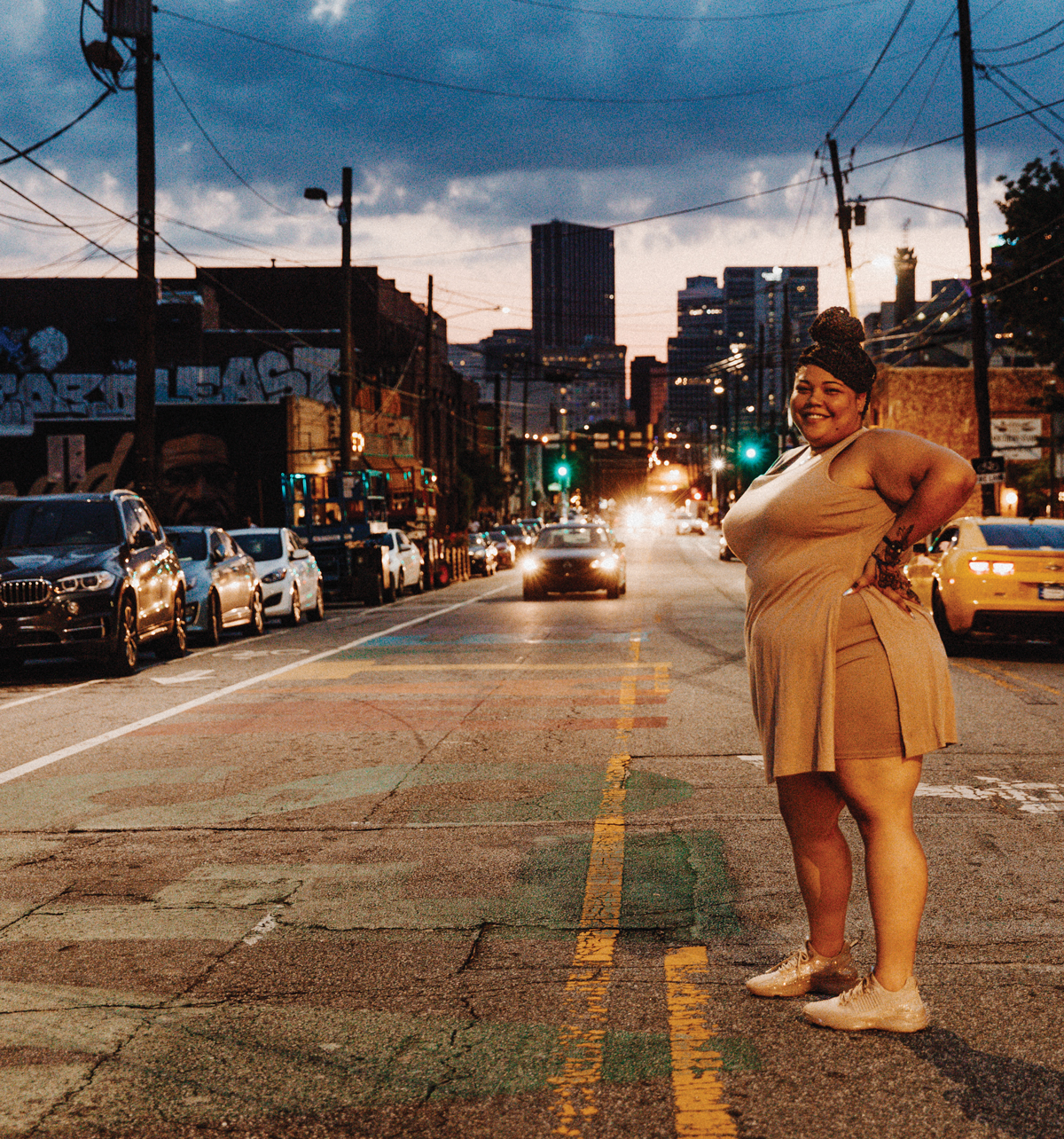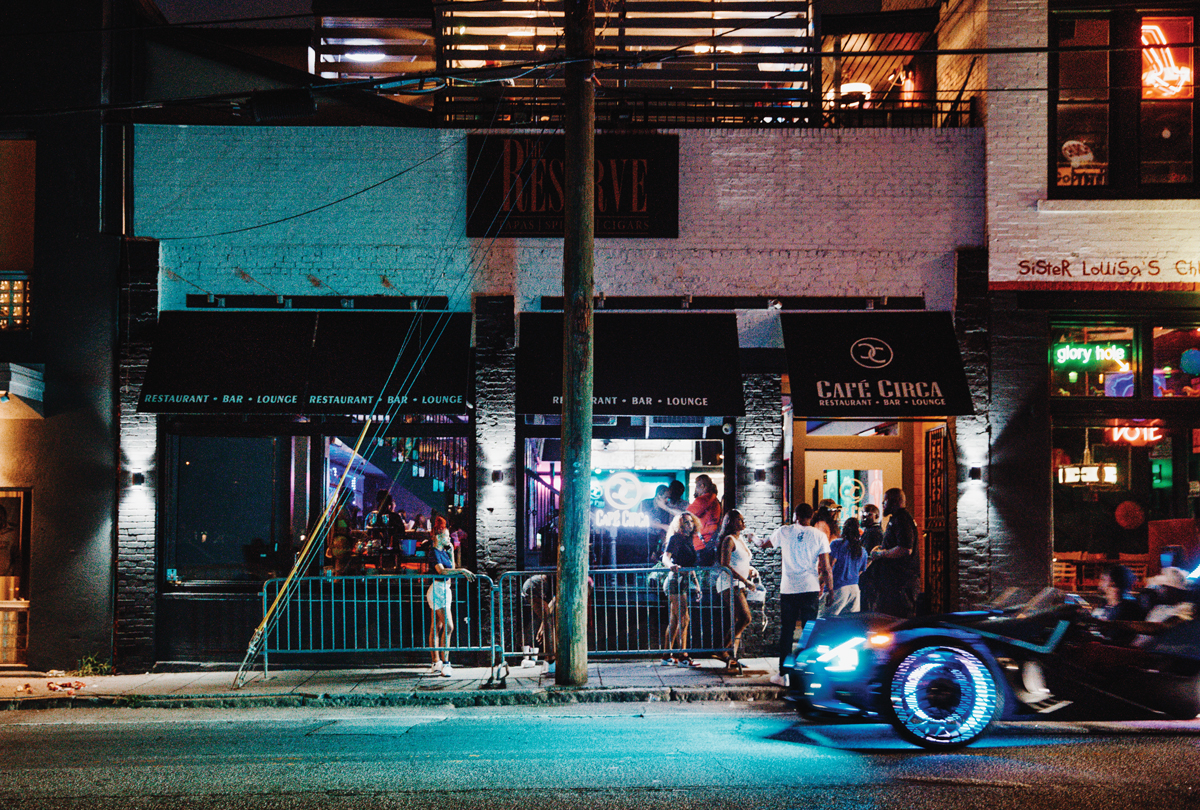This story is part of Atlanta magazine’s Streets Issue—a block-by-block exploration of our city and the stories it tells. Find the entire package here.
Edgewood Avenue: Where our perpetual conundrums remain
From the symbols of the city to the scene that drives the culture, perhaps no street balances Old Atlanta and New Atlanta quite like Edgewood Avenue.
Edgewood begins downtown at the original Five Points—the intersection with Marietta, Decatur, and Peachtree streets, just beneath the iconic red sign marking the spot where, in 1886 at Jacob’s Pharmacy, customers got their first taste of a fizzy beverage that would help put Atlanta on the map: Coca-Cola. East from here, passing the Sweet Auburn Curb Market along the Atlanta Streetcar tracks and crossing underneath the I-75/85 overpass, there’s a sense of a gritty, burgeoning Atlanta that’s currently finding, refining, and reminding itself what it used to be—and what it could be.
This portion of Edgewood Avenue is home to entrepreneurial landmarks—Miya Bailey’s City of Ink, Killer Mike’s Swag Shop—as well as watering holes like Noni’s and Georgia Beer Garden, where, on any weekday evening, civic advocates might gather in the courtyard while novice stand-up comedians test new material at the bar. Add to this a collection of public murals that pay homage to beloved local and national figures, fallen heroes, and a political activism that both connects to and updates Atlanta’s civil rights legacy: from George Floyd to Grip Plyaz, Nipsey Hussle to Colin Kaepernick, DJ Speakerfoxxx to prominent Black women activists Selena Sloan Butler, Mother Mathilda Beasley, Annie L. McPheeters, and Dorothy Bolden Thompson. Edgewood is where Atlanta goes for both revelry and remembrance.

Photograph by Growl

Photograph by Growl
Edgewood’s visual identity, combined with the plethora of bars and restaurants, helps provide the backdrop to a social scene that’s urgent, vibrant, and intentional. On warm nights, Atlanta’s “culture” feels plentiful and audacious—punctuated by Our Bar ATL’s “DIS ATL HOE” neon sign and the brick walls of Sister Louisa’s Church (it’s a bar!), which skew slightly political, with depictions of Stacey Abrams, Jon Ossoff, Raphael Warnock, and Jimmy Carter.
From Edgewood Avenue’s intersection at Boulevard to its dead end at the Inman Park/Reynoldstown MARTA station, there’s a sense of the new and renewed. The legendary SoundTable is gone, but Slutty Vegan, Chrome Yellow, and Revolution Doughnuts appear to be thriving, and construction cranes rising above the street as it passes over the Atlanta BeltLine signal even more change on the horizon—if the new townhomes at the Krog Street intersection, starting at $1 million, are any indication.
But sunrise on Edgewood Avenue is a study in contrasts, as a significant number of unhoused people—many of them Black—awake from their overnight digs in front of or nearby the very establishments that only hours before were full of life. It’s a stark reminder of Atlanta’s perpetual conundrum, as a city that fosters promise and prosperity against a backdrop of extensive poverty. The people experiencing poverty seem to blend right in here, in a way that feels all too common. It shouldn’t be. Those we can’t ignore or sacrifice or leave behind are a part of Edgewood Avenue’s imperfect beauty, which makes it the most “Atlanna” street of them all—for who it brings together, what it pays homage to, and the challenges we have yet to solve as a city.
 Moreland Avenue: Where Atlanta’s past meets its future
Moreland Avenue: Where Atlanta’s past meets its future
Chances are you’ve spent a wild night or three on it, but it’s more than a nightlife locale: Moreland Avenue is a cultural icon. A place where record stores and restaurants, comedy and live music, Starlight Drive-In and the Doll’s Head Trail come together. It’s a frantic, entertaining stretch of road that’s sometimes chaotic and oftentimes lovely. It’s quintessentially Atlantan.
After the Civil War, “Moreland Avenue was little more than a dirt path along the county line,” according to the East Atlanta Community Association. It would eventually evolve into a packed stretch of stores—some iconic and long-lasting, like Little Five Points Pharmacy and Sevananda—while connecting myriad neighborhoods and stretching south, all the way past the Perimeter. Real quick: Can you name another Atlanta street that was once home to not one (1) but two (2) Zestos? (You can’t. It’s just one of the many reasons why Moreland is cooler than an Arctic Swirl.) Our city is known for its always-evolving food scene, and the restaurants opening on or just off of Moreland—OK Yaki, Pollo Primo, and Banshee—live up to that rich history.
It’s a connective thoroughfare, with two MARTA stations and multiple bus routes. You could be walking along it one minute and running into André 3000 the next. It’s the junction of annual events like Inman Park Festival and Candler Park Music Festival. A place where the L5P Halloween Parade delights onlookers, but also a place where many ATLiens have shaken their fist at traffic. Moreland Avenue contains multitudes.
And we haven’t even touched on Southern Comfort, a legendary honky-tonk, the husk of which lies just outside the Perimeter in Conley. It served as a watering hole since time immemorial, played home to countless local bands—including Mastodon and the Black Lips—over the years, and hosted the best karaoke night in the metro. (Shout-out to Mary’s, also just off Moreland, which now holds that distinction.) Here’s hoping SoCo finds its ninth life someday soon.
But you can’t talk about Atlanta without talking about racism, and that goes for Moreland, too. After Reconstruction, white people changed the street names in certain neighborhoods to avoid sharing an address with Black people. That’s why Moreland turns into Briarcliff Road at Ponce. (These kinds of fools still exist here, but they’ve found new and sneakier ways to avoid people who are different from them: voting against affordable housing in neighborhood meetings.) But if Moreland represents what Atlanta was, it also represents what it can be. One example: The Atlanta Motel, thanks to the efforts of a couple local organizations, will soon be repurposed as a residence for unhoused people.
But back to those wild nights. The next time you’re doing something fun and perhaps a bit foolish in L5P (a weeknight show at Variety Playhouse, one too many drinks at Euclid Avenue Yacht Club, maybe some fashionista shenanigans at Factor’s), walk south along Moreland as it gets late and take your life into your hands as cars race by you underneath DeKalb Avenue. It’s a singular moment—a little dangerous and a lot thrilling. It’s magical and loud and unsettling. It’s ATL at its finest.
This article appears in our August 2022 issue.














